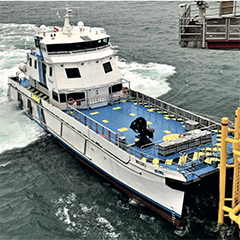Riding a wave of green innovation
MHO-Co is on a mission towards a greener and more economically viable service to the offshore industry. And the future is already here. Right now, the Danish shipping company is building the world’s first hybrid CTVs which are to be introduced in 2021. And they hope to take the technology even further with support from EU funds.
With eyes set on the future and a vision to create an environmentally friendly way of business MHO-Co has designed two new hybrid catamarans with modern electric motors reducing weight, space and emission for the benefit of the environment as well as fuel economy in the offshore wind industry.
‘Designing and building hybrid crew transfer vessels is a huge step in the environmental direction, and I am proud that we have found partners who share our vision for sustainable development in the offshore industry. With these new vessels we offer the largest, most reliable, and sustainable CTVs in the world,’ says CEO and founder of MHO-Co, Mik Henriksen.
Creating a ship that is the first in the world of its kind is a very special process. And of course, Mik Henriksen, who designed the twin vessels in cooperation with Incat Crowther, wants to follow every detail as the construction comes along. But building ships in the middle of a pandemic chances everything.
In June, MHO-Co signed a contract with AFAI Southern Shipyard in Guangzhou, China. The largest shipyard in Asia specializing in the development, design and construction of high-performance aluminum vessels. Due to international traveling restrictions, the signing ceremony was performed online, and since then Mik Henriksen has followed the construction directly from his desk in Esbjerg, Denmark.
Every day he is in close contact with the shipyard and the local agent in Guangzhou. On a normal day they exchange more than 30 e-mails discussing the progress and technical details. And Mik Henriksen also follows the construction on site through six fixed position web cameras placed round the vessels in the shipyard, and one mobile camera to do inspections up close.
Riding a wave of green innovation
MHO-Co is on a mission towards a greener and more economically viable service to the offshore industry. And the future is already here. Right now, the Danish shipping company is building the world’s first hybrid CTVs which are to be introduced in 2021. And they hope to take the technology even further with support from EU funds.
With eyes set on the future and a vision to create an environmentally friendly way of business MHO-Co has designed two new hybrid catamarans with modern electric motors reducing weight, space and emission for the benefit of the environment as well as fuel economy in the offshore wind industry.
‘Designing and building hybrid crew transfer vessels is a huge step in the environmental direction, and I am proud that we have found partners who share our vision for sustainable development in the offshore industry. With these new vessels we offer the largest, most reliable, and sustainable CTVs in the world,’ says CEO and founder of MHO-Co, Mik Henriksen.
Creating a ship that is the first in the world of its kind is a very special process. And of course, Mik Henriksen, who designed the twin vessels in cooperation with Incat Crowther, wants to follow every detail as the construction comes along. But building ships in the middle of a pandemic chances everything.
In June, MHO-Co signed a contract with AFAI Southern Shipyard in Guangzhou, China. The largest shipyard in Asia specializing in the development, design and construction of high-performance aluminum vessels. Due to international traveling restrictions, the signing ceremony was performed online, and since then Mik Henriksen has followed the construction directly from his desk in Esbjerg, Denmark.
Every day he is in close contact with the shipyard and the local agent in Guangzhou. On a normal day they exchange more than 30 e-mails discussing the progress and technical details. And Mik Henriksen also follows the construction on site through six fixed position web cameras placed round the vessels in the shipyard, and one mobile camera to do inspections up close.
To read the full content,
please download the PDF below.















